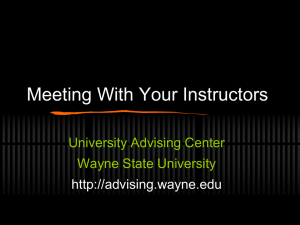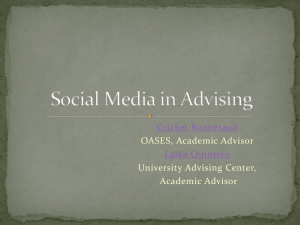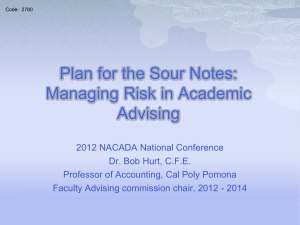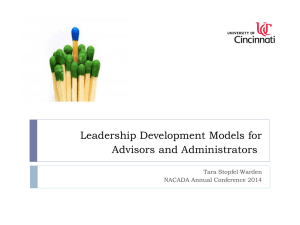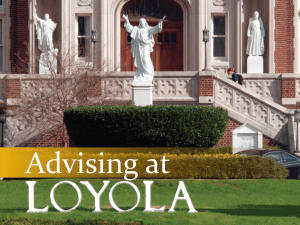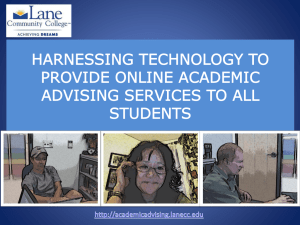Academic Advising Steering Committee, Presentation to Faculty
advertisement
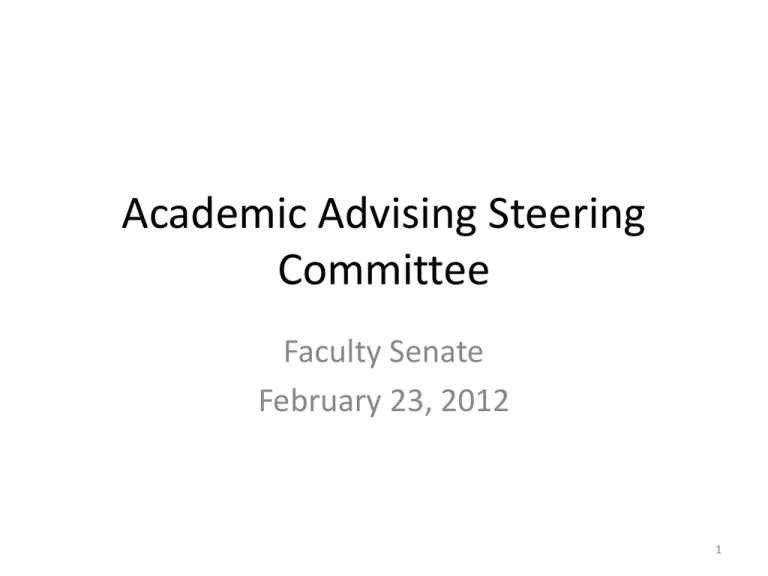
Academic Advising Steering Committee Faculty Senate February 23, 2012 1 Committee charge To provide the highest quality of academic advising for all students, from admission to graduation, a campus-wide committee (April 2011) was charged with helping to design a comprehensive advising plan that will 1) 2) 3) Identify goals of effective academic advising and standards of practice for advising all students Define assessment processes, and reward/recognition models for all advising functions Maximize current resources available, and identify new resources needed to reach our goals In order to achieve full adoption of the final advising plan, it should be consistent with articulation agreements and be endorsed by the Academic Deans as well as the Enrollment Services Advisory Committee. 2 Committee members • • • • • • • • • • • • • • • • • • • • Co-chairs Teaching Effectiveness Committee chair Arts and Sciences: Business: CELS: Pharmacy: Engineering: Nursing: HSS: UC: CCE: Student Affairs: Faculty Senate: Education: Student representatives: Enrollment services: Talent Development: Communication Studies: IEP: Psychology: Mike Honhart (Sen Exec Com), Jayne Richmond (UC) Jim Kinnie Earl Smith, Matt Bodah Peg Boyd, Kathryn Jervis Ann Veeger, Kim Anderson Ron Jordan, Denise Gorenski George Veyera Michaela Mooney Nancy Kelley Linda Lyons Tammy Vargas Jason Pina Mike Honhart Kees De Groot Chris Caisse Jack Humphrey Sharon Forleo/Joanna Ravello Lynn Derbyshire, Martha Waitkun Sigrid Berka Trish Morokoff/Su Boatright members are jointly appointed by Faculty Senate Executive Committee and the Provost for terms of 1-3 years, include at least one representative from each college, one representative from Enrollment Services, and the Chair of the Teaching Effectiveness Committee 3 Committee priorities • Identify best practices for excellent advising for students and advisors – UC and each degree-granting college • Clarify policies and practices in all colleges, including expectations of faculty, staff, and students, from “Admission to Graduation” • Make recommendations for maximizing current resources and requests for new resources • Provide models for advisor handbooks, advising mission statements, and advising web statements • Conduct cost analysis of opportunities and losses for various advising models • Identify and make recommendations regarding recognition and reward structures 4 Best practices examples of our focus • Advisor role assignments – Reward and recognition (release time, T&P, appt. letters, ratios, summer and intersession) • Communication between advisors and advisees – Welcoming letters, advising statements, expectations, assignments, graduation time lines – Early Alert notifications, semester progress evaluation – Information about the major, standardized curriculum templates within each college • Technology – Use of URIadvisement (office hours, contact notes), degree audits (APR), transfer credit evaluations (TES, NOLIJ, prior approval), query resources 5 Best practices – examples cont. • Training – – – – – – – Monitoring academic progress Using advising technology (URIadvisement, MapWorks, TES, APRs, queries) Referrals (Early Alert, Honors, AEC) Group advising, individual advising, student outreach Curriculum knowledge – major, general education requirements Special populations- probation, undeclared, honors, athletes, DSS Academic policies - dismissals, conditional, readmissions, second grade options, petitions, prior approvals, academic calendar, FERPA – Use of advisor holds • Assessment – Learning outcomes (CAS and NACADA) – Student and advisor self evaluation • Knowledge • Satisfaction • Effectiveness – Cost analysis and retention consequences 6 Next steps • Report to Provost with recommendations • Share campus-wide resources around best practices: – – – – Handbook – policies and practices Communication Training Assessment • Create on-going advising oversight committee with focus on resource needs and assessment 7 Sample web statement • Our college is committed to accurate and timely advisement, frequent communication with advisees, integrity of the student’s academic record, and an emphasis on academic success, achievement and challenge. Each student will be encouraged to create an academic plan, well-suited to their aptitudes and interests, with a long term goal of maximizing campus offerings while still achieving timely graduation. 8
